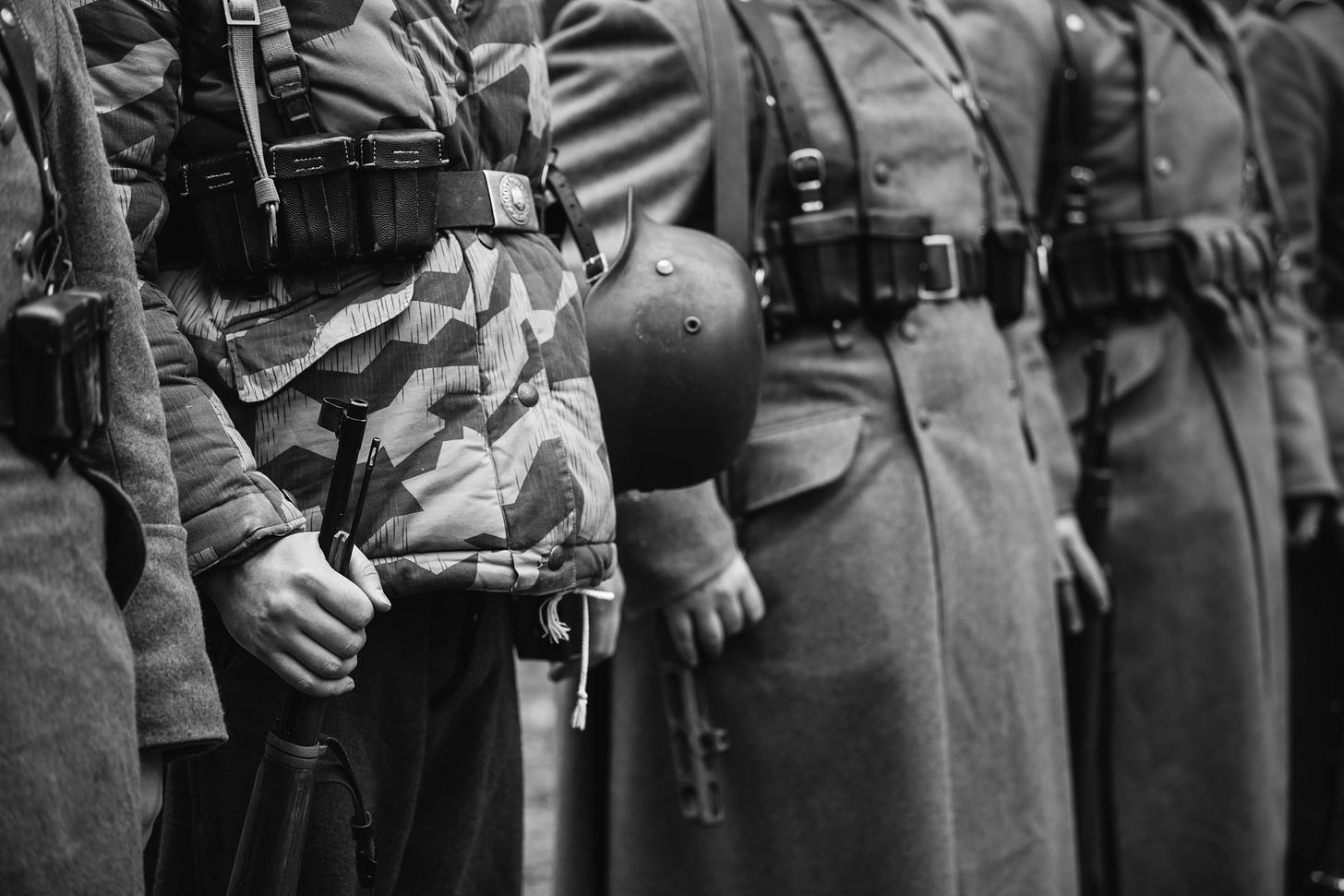It’s Not Just Tarrifs. It’s a Setup. Watch out, Elon.
From Tech Bro to Fall Guy— The Crisis is Coming, and the Strongman Playbook is Already in Motion
On the same day that Donald Trump announced his sweeping new tariffs— tariffs so large and so reckless they could send the economy into a tailspin— he also quietly turned on Elon Musk.
To some, it might seem like political drama. To me though, it looks like the opening move in a familiar authoritarian playbook.
Here’s my prediction: Trump knows these tariffs will wreck the economy. That’s part of the plan. When things inevitably crash, he’ll point the finger at a convenient scapegoat— someone already polarizing, someone already falling out of favor. Elon Musk fits the bill perfectly. Once blame is placed, Trump will use the chaos as justification to consolidate power, possibly under the guise of an “emergency”.
This isn’t new. Authoritarians throughout history have followed the same three-step formula: crash the system, blame a flashy villain, and swoop in as the “hero” with extraordinary powers.
Let’s look at the receipts.
The Authoritarian Pattern (and its modern remix)
What trump appears to be doing isn’t new. Authoritarians throughout history have ruled on the same well-worn pattern to consolidate power:
Create or exploit a crisis
Blame a convenient scapegoat
Use the chaos to seize extraordinary powers
Sometimes the crisis is natural or external. Sometimes it’s orchestrated. Either way, the formula works. When people are scared. They’re more willing to surrender rights and democratic norms in the name of “order”. And when there’s someone flashy and unpopular to blame, even better — public outrage can be redirected away from those actually pulling the strings.
But in the 21st century, this pattern has gotten a tech bro update.
Over the past decade, a network of tech elites, ideologues, and billionaires have openly questioned whether democracy is even worth keeping. At the center of this is Curtis Yarvin, a former software engineer turned political theorist who argues that America needs a CEO-style monarch to replace its “inefficient” democratic government. His ideas—once niche and fringe — have slowly made their way into elite circles over the last 10-15 years. Amplified by figures like Peter Thiel (the billionaire startup investor of PayPal and the mentor and biggest financial backing of JD Vance), and even the alleged “Special K” connoisseur and chainsaw enthusiast Elon Musk himself.
This isn’t just about some intellectual blog posts in the background.
When Yarvin talks about “managing a crisis to reset the system,” or building “patchwork governance” by dismantling democracy, he’s laying out exactly the kind of moment I believe we are entering now.
Trump, whether he’s formally aligned with Yarvin or not, operates from the same authoritarian instinct: break the system, weaponize the fallout, consolidate control.
And historically, the tactic works.
Now before I give you the historical receipts with examples from the likes of Hitler, Putin, Erdogan, and even Bush… It’s important to understand how we got here.
The Yarvin-Thiel-Musk Triangle: From Theory to Playbook
To understand how we got here, you have to look at the strange alliance that’s formed between political reactionaries and Silicon Valley elites. At the center is Curtis Yarvin, the godfather of the Neoreactionary (NRx) movement — a group that doesn’t just critique democracy, but argues for replacing it with authoritarian rule.
Yarvin believes America should be run more like a startup, with a CEO-style monarch(s) in charge, unconstrained by public opinion or elections. He’s written extensively about how a crisis is often the fastest way to reset a political system- especially when paired with a strongman willing to “take control.”
Enter Peter Thiel, the billionaire venture capitalist who’s not only funded Yarvin, but also supported candidates like Trump and J.D. Vance — figures aligned with post-democratic, power- consolidating visions. Thiel famously said, “I no longer believe that freedom and democracy are compatible.”
And there’s Elon Musk- once the hero of techno-optimism- now knee deep in culture war rhetoric and erratic policy flirtations. Musk has retweeted Yarvin, echoed NRx-adjacent talking points, and used his platforms to promote anti-democratic sentiment, often under the guise of “free speech”.
Together, these three form a triangle of influence:
Yarvin writes the authoritarian script
Thiel bankrolls and legitimizes it
Musk popularizes it and plays the wildcard
So when Trump starts moving in that same direction— manufacturing crisis, targeting enemies, and promising order— it’s not happening in a vacuum. He’s operating in an ecosystem where this kind of anti-democratic power play has been normalized, even romanticized.
And now? Musk may be about to serve a new role in that story — not as the hero of it, but as the fall guy.
Crash, Blame, Control— The Historical Receipts
The formula may feel modern, but it’s been used by strongmen for over a century. Trump’s moves— crash the economy, scapegoat a high-profile villain, and grab emergency powers— fit neatly into a well-worn authoritarian playbook.
Let’s look at a few of the clearest examples:
Hitler and the Reichstag Fire (Germany, 1933)
The Crisis: A mysterious fire destroyed the German parliament building.
The Scapegoat: A Dutch communist was arrested, and the Nazis blamed the broader leftist movement.
The Power Grab: Hitler used the fire to pass the Reichstag Fire Decree, suspending civil liberties, banning opposition parties, and paving the way for dictatorial control through the Enabling Act.
This is one of the clearest historical examples of a manufactured or exploited crisis being used to dismantle democracy in broad daylight.
Putin and the 1999 Apartment Bombings (Russia)
The Crisis: A series of apartment bombings in Russian cities killed hundreds.
The Scapegoat: Chechen rebels were blamed—though some evidence has since suggested state involvement or at least complicity.
The Power Grab: Putin, then little-known, launched the Second Chechen War in response. His strongman image was solidified overnight, leading to his rapid rise to power and two decades of authoritarian rule.
Viktor Orbán and the COVID-19 Pandemic (Hungary, 2020)
The Crisis: The global coronavirus pandemic.
The Scapegoat: Foreigners, the EU, and liberal elites were framed as undermining Hungary’s national response.
The Power Grab: Orbán passed a bill allowing him to rule by decree indefinitely, bypassing parliament. He used the moment to tighten media controls, crack down on NGOs, and silence critics—all under the banner of emergency powers.
Orbán openly stated that "liberal democracy is over" and has modeled his regime as an “illiberal state.”
Ferdinand Marcos and Martial Law (Philippines, 1972)
The Crisis: A series of bombings and civil unrest in Manila—some later believed to be staged or exaggerated.
The Scapegoat: Leftist activists and communist insurgents were blamed for destabilizing the country.
The Power Grab: Marcos declared Martial Law, dissolved democratic institutions, jailed opponents, and ruled by decree. He used the chaos to extend his presidency beyond legal limits, looting billions from the country in the process.
Marcos explicitly said democracy had become “too free” and needed discipline—sound familiar?
Benito Mussolini and the March on Rome (Italy, 1922)
The Crisis: Post-WWI instability, economic depression, and mass strikes.
The Scapegoat: Socialists, labor unions, and “weak liberal governments.”
The Power Grab: Mussolini staged the March on Rome, presenting himself as the only one who could restore order. The king gave in and made him Prime Minister. Within years, Mussolini dismantled Italy’s democracy, banned opposition, and became a full dictator.
This was a slow-moving coup wrapped in nationalism and emergency rhetoric.
Jair Bolsonaro and the 2022 Election (Brazil)
The Crisis: Bolsonaro falsely claimed Brazil's electoral system was corrupt and rigged.
The Scapegoat: Election officials, the courts, and ultimately Luiz Inácio Lula da Silva (his opponent).
The Power Grab Attempt: Though he didn’t succeed, Bolsonaro egged on a January 6–style insurrection, hoping to delegitimize the vote and justify military or emergency intervention.
Even in failure, he followed the playbook: create chaos, blame enemies, and try to seize control.
Erdogan and the 2016 Coup Attempt (Turkey)
The Crisis: A failed military coup, the details of which remain murky.
The Scapegoat: Fethullah Gülen, a Turkish cleric living in exile, was blamed—along with thousands of alleged sympathizers.
The Power Grab: Erdogan declared a state of emergency, purged over 100,000 civil servants, jailed journalists, and rewrote Turkey’s constitution to centralize power in the presidency.
A suspiciously convenient “crisis” that became the launchpad for full-on authoritarianism.
Bush and the Post-9/11 Patriot Act (U.S., 2001)
The Crisis: The September 11 terrorist attacks.
The Scapegoat: Al-Qaeda, of course—but also a broad targeting of Muslim communities, civil liberties, and dissenters.
The Power Grab: The Patriot Act expanded surveillance powers dramatically, enabled warrantless wiretapping, indefinite detentions, and secret court processes.
*While not authoritarian in the classic sense, it showed how easily fear and national trauma can be weaponized to erode freedoms and increase executive power.
Each of these leaders used a crisis to justify actions they couldn’t have gotten away with under normal circumstances. These examples span different eras and ideologies, but the core tactic and pattern is always the same: something burns, someone gets blamed, and the “strongman” steps in to save the day— while destroying the very system he claims to protect.
Sound familiar?
If you haven’t yet read my article about the Looming Threat of Martial Law- make sure to check it out, as I show the receipts for how Trump has been setting up the perfect framework to use it soon:
The Looming Threat of Martial Law
Imagine waking up to a nation transformed overnight. The President has invoked the Insurrection Act, citing a “national security crisis” or “widespread defiance of federal authority”. Armored military vehicles patrol the streets, checkpoints are established, and National Guard troops are deployed to enforce mandatory curfews and restrict movement. In ad…
Why Musk Makes the perfect Scapegoat
Elon Musk was never a loyal foot soldier— he was a useful one. For years now, he has amplified anti-democratic ideas, boosted reactionary thinkers like Curtis Yarvin, and helped normalize the idea that democracy is outdated and “inefficient.” He courted the right and gave them the perfect echo chamber to which the President has loved to get his “thoughts” quickly tweeted out.. He has flirted with power, and positioned himself as a kind of techno-kingmaker.
But now? He’s become the perfect fall guy.
He’s polarizing. He’s erratic. And his reputation is already unraveling thanks to platform chaos, business misfires, and increasingly bizarre public behavior. Turning on Musk gives Trump a flashy scapegoat — someone big enough to distract, arrogant enough to alienate people, and detached enough from the political machine to be thrown under the bus without real cost.
It’s a bait and switch.. blame the billionaire who once played the game. Then use that outrage to justify more control, more intervention, more “emergency” action.
The very people who helped push the anti-democratic narratives are now being set up to be the reason democracy is “failing.”
This Was Always the Endgame
None of this is accidental. The economic crash is foreseeable. The scapegoating is strategic. And the coming calls for “strong leadership” and “emergency powers” will be sold as common sense.
But this isn’t about tariffs or tech feuds. It’s not even just about Elon Musk. It’s about power.
Trump doesn’t need a coherent economic plan— he needs chaos. Because in chaos, authoritarians thrive. They step in with promises of order, safety, and strength— while stripping away democracy piece by piece. We’ve seen this pattern over and over again, across countries and centuries.
The twist this time is that he’s doing it in the open. And he’s doing it with a trail of enablers.. From Silicon Valley monarchist to Ultra Right Wing Christian Nationalist— both whom never thought the fire would burn them.
But it will. That is, if it works for him..
See here’s the difference this time: more people are watching. More people are awake.
These tactics are no longer invisible. The authoritarian blueprint is being exposed in real time. And as the word spreads— across social media, in articles like this one, in conversations with friends and family— the power of the playbook begins to unravel. Authoritarians rely on confusion, distraction, and silence. When we name what’s happening, that grip starts to break.
So stay sharp. Keep calling it out. Don’t go silent — he’s counting on it in the months ahead. Keep sharing what you know. Because when The People stop falling for the con, the strongman’s stage starts to collapse beneath him.
And it will.









Lock in, my friend. Don’t say “Thiel is connected to Vance”. Say “Thiel has entirely funded Vance’s political career”
It was only a matter of time before Musk felt those bus wheels rolling over his back. His doom was sealed when he couldn’t buy the Wisconsin Supreme Court seat for Trump. That, along with Trump’s sinking poll numbers made this outcome all but inevitable. He is no longer useful to Trump.